Description and cultivation of myrikaria
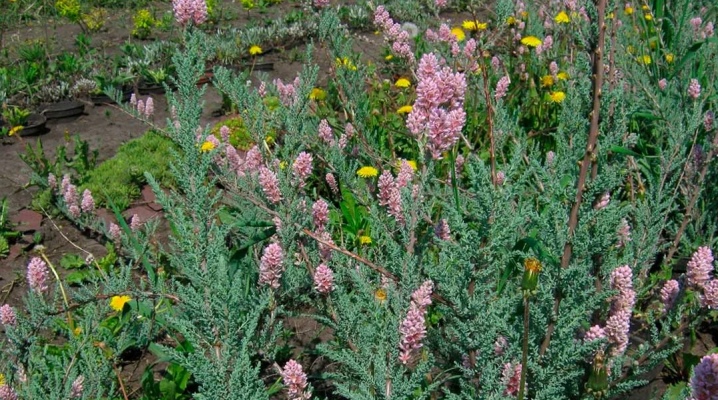
Now, many gardeners are interested in describing both the myrikaria itself and the peculiarities of growing this crop. This plant is prized for its unique appearance. It is the unusual shape of foliage, silvery branches and bright buds during the flowering period that make it possible to use myrikaria in landscape design. HAn even less important point is the unpretentiousness of the plant.
general description
Mirikaria is a representative of the Tamariskov family (Grebeshkovs). The vast majority of varieties of this plant are found in Asian lands. To date, scientists have identified 13 species, but there is still no consensus regarding the complete composition of the genus.
The Mirikaria prefer forests and mountains. They are able to form low-growing clumps with creeping contours. By the way, plants can climb to a height of about 2 km above sea level. There they are located on plateaus and hills.

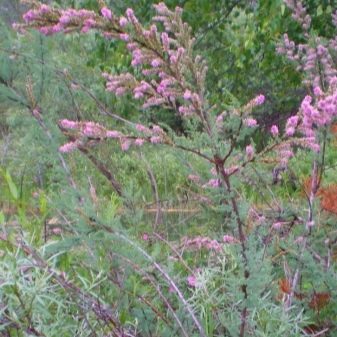
All varieties of myrikaria are shrubs or semi-shrubs with a perennial form of growth. Under natural conditions, the height of the shoots rarely exceeds the mark of 4 m. When the plant is cultivated in a temperate climate, these indicators vary from 1 to 1.5 m. By the way, the width of the shrub can be similar. It is worth considering that the shoots of myrikaria grow either straight or spread along the ground, and their number in one bush can be from 10 to 20.
During flowering, buds are formed, the main feature of which is the elongated bracts. Inflorescences are formed at the tops of the shoots and their lateral branches from small bisexual flowers. They can take the form:
- spikelets;
- brushes;
- panicles.
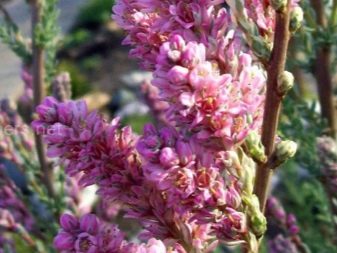
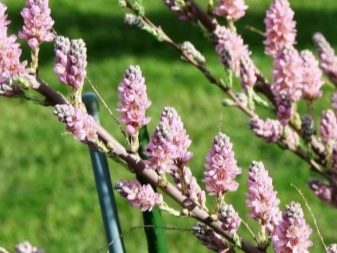
All inflorescences are attached to elongated flowering stems, the length of which reaches 0.4 m.
The fruits of myrikaria are seed pods that are pyramidal in shape. Distinctive features of the seeds are their small size and the presence of awns covered with whitish pile. Thanks to this feature, during the period of active fruiting, the entire shrub becomes, as it were, fluffy. It is also worth focusing on the absence of tissues, which are an integral attribute of the seeds of most flowering and gymnosperms.
In addition to all of the above, it is worth highlighting the winter hardiness of the described representatives of the flora. An equally important point is the ease of maintenance. Myricaria can be propagated both by seeds and vegetatively (for example, by cuttings).
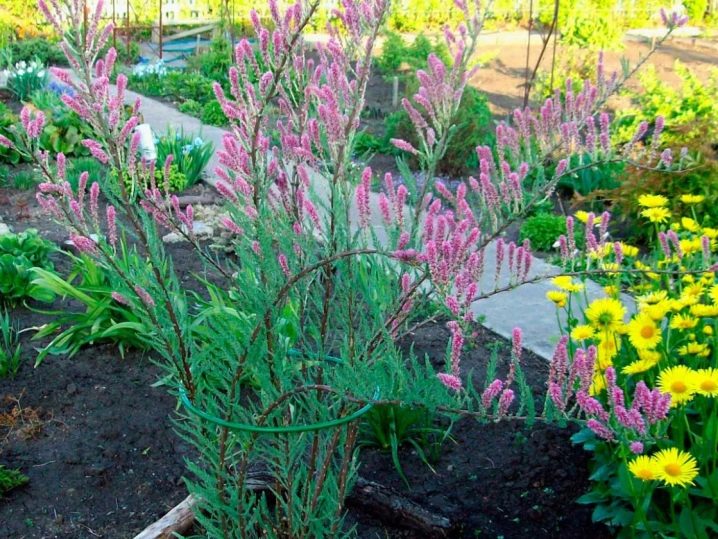
Popular types
It is worth noting that today, with all the diversity of the genus in question, only a few species are used in ornamental gardening. These include, for example, myrikaria graceful, which is a rather exotic variety for our territories. This plant looks like a shrub or small trees. By the way, the latter reach a height of no more than 5 meters.
Older branches of graceful myrikaria are dark purple or reddish brown in color. In turn, young shoots will be green and reddish brown. Leaf plates on first-year branches are sessile and have elliptical, elliptical-lanceolate and ovo-lanceolate shapes. Their length and width are 5-15 cm and 2-3 mm, respectively.
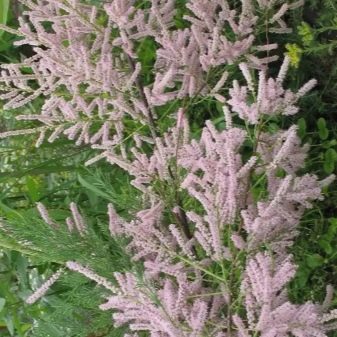
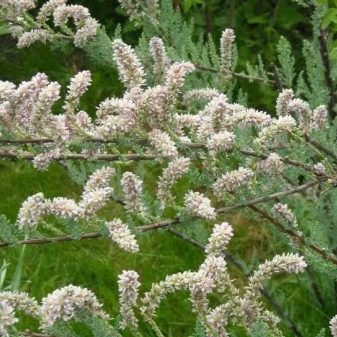
Consider other popular types.
Foxtail
This type is now the most common and deservedly popular among modern gardeners. The natural habitat of this species of myrikaria is the European part of the Russian Federation. The plant is also found in the southern part of Siberia and in Western Europe. The foxtail myricaria grows in the regions of Central and Central Asia and often in the Middle East.
The species has the following key features:
- shrub growth;
- sprawling and rather graceful shoots;
- height not exceeding a mark of 2 meters;
- branches entirely covered with leaf plates, which are arranged alternately;
- flowering, which occurs in the last spring month and continues until the end of summer;
- a large number of small-sized pale pink flowers that form beautiful inflorescences, which are concentrated closer to the tops of the shoots (the length of such clusters over the entire period of development can exceed their original size several times and reaches 30-40 cm).
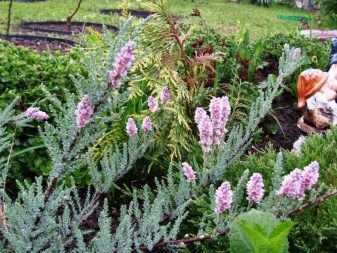
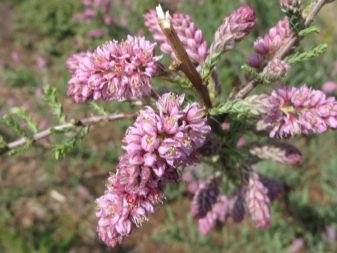
It is important to note that it is the peculiarities of the flowering process that determine the uneven formation of fruits. In autumn, the seed pods, reaching the peak of their maturity, are opened. It is noteworthy that the seeds have awns with a hairy covering, which makes the branches of the plant look like a fox's tail. Taking into account this feature, the name of this type of myrikaria is associated.
Daurskaya
This myrikaria, which is also called long-leaved, is found in the south of Eastern Siberia, Altai and Mongolia. It grows both singly and in whole groups, often choosing the coastal zones of water bodies. The shrub reaches a height of two meters, and its crown is distinguished by openwork contours.
The main distinctive features of the species:
- old branches are grayish-brown in color, and young (annual) shoots are greenish-yellow in color;
- leaf plates are pale green or greenish-gray;
- sessile leaves of an elongated ovoid form are formed on primary shoots, and linear-lanceolate on secondary ones;
- the length and width of the plates vary from 0.5 to 1 cm and from 1 to 3 mm, respectively (while their surface is literally covered with small glands in the form of dots).
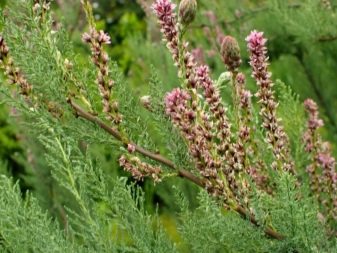

Daurian myrikaria blooms from May to August with the formation of inflorescences in the form of brushes of various (sometimes the most bizarre) shapes on the tops of one-year-old and young branches.
As soon as pollination is completed, the ripening of fruits begins, which ultimately have the appearance of narrow bolls. After full maturation, they open in three segments (valves). These natural containers are filled with small seeds a little over a millimeter in size. Each of them has an awn, half covered with light (whitish) hairs. By the way, for decorative purposes, this variety of the described plant began to be cultivated in the 19th century.
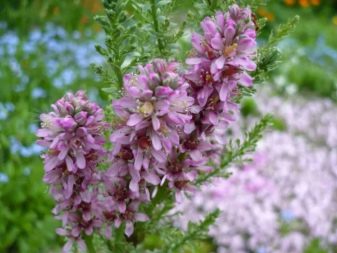
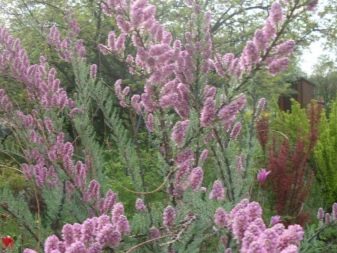
Landing
Before planting myrikaria in open ground, it is necessary to correctly determine the location. An open and well-lit area with the sun will be optimal here. The seedling can develop well in partial shade, however, such conditions in the future will negatively affect the quality of flowers and the duration of flowering.
It is also advisable to plant bushes in places protected from cold winds and drafts. On the other hand, in some situations there is a risk of damage to young plants by the direct rays of the scorching sun. But it is important to note that the described culture is distinguished by good endurance in the context of temperature regimes. As a rule, myrikaria is able to withstand frosts, in which the thermometer drops to -40 degrees. And also she will feel great when raised to +40.
The next important points related to the peculiarities of planting are the composition and quality of the soil. It is highly recommended to opt for loose and fertile soil. Gardening and light to medium loamy soil with peat chips are good options.Attention should be paid to acidity indicators, which should be medium (pH at 6.5-7) or slightly acidic (that is, 5-6). To improve the properties of the substrate, gardeners add nitroammofosk or ash to it.
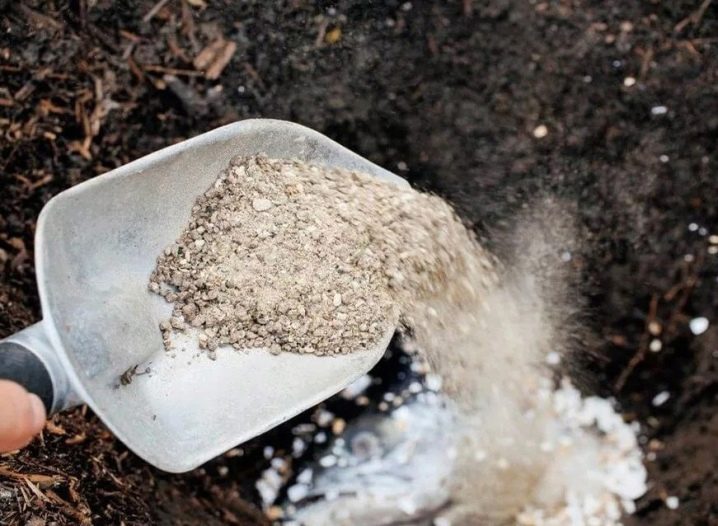
Bushes are planted at the initial (spring) or final (autumn) stage of the growing season. In this case, the algorithm of actions will look as follows.
- Dig a hole for a seedling, the length, width and depth of which is 0.5 m.
- A drainage layer with a thickness of about 0.2 m is laid at the bottom. Crushed stone, expanded clay and even broken brick can be used as material.
- The drainage is covered with a pre-prepared substrate.
- The seedlings are installed so that the root collar is at the level of the soil surface.
- Fill the pit with soil mixture, which must be slightly compacted.
- Watering is carried out.
- Mulch the near-trunk zone with humus, peat or tree bark. This will preserve moisture in the soil, and will also prevent the emergence and reproduction of weeds. The thickness of the mulch layer should be from 10 cm.
Summing up, it is necessary to focus on the selection and preparation of planting material. The best option would be cuttings (seedlings) no older than two years of age. It should also be remembered that when planting in the ground, the transshipment method is used, which provides for the preservation and transfer of the earthen clod.
An equally important point is the distance between the bushes, which, taking into account their properties, should grow from 1 to 1.5 m.

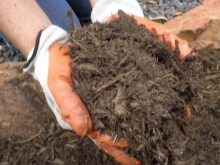
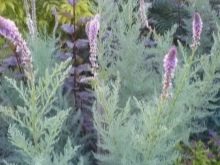
Care
Taking into account the unpretentiousness of the culture, it is quite easy to care for it. When growing myrikaria and forming bushes, it is important to consider that the plant has spreading branches. They may well suffer from strong winds, so it is important to choose the right landing site. Otherwise, you will have to take care of arranging the shelter. Loosening of the soil and weeding after rains and irrigation will be no less important agrotechnical measures.
The good news is that this plant is poisonous. This provides a fairly effective protection against various harmful insects. As practice shows, myrikaria also rarely gets sick. At the same time, experienced gardeners do not recommend getting carried away with the irrigation of the bushes.
Watering
In the absence of sufficient rainfall, plants should be watered every 2 weeks. At the same time, the watering rate is a bucket of water for each planting unit. Irrigation may not be required under normal rainfall conditions.
It is important to consider that myrikaria copes well with drought. At the same time, excessive soil moisture can be detrimental to plant roots.
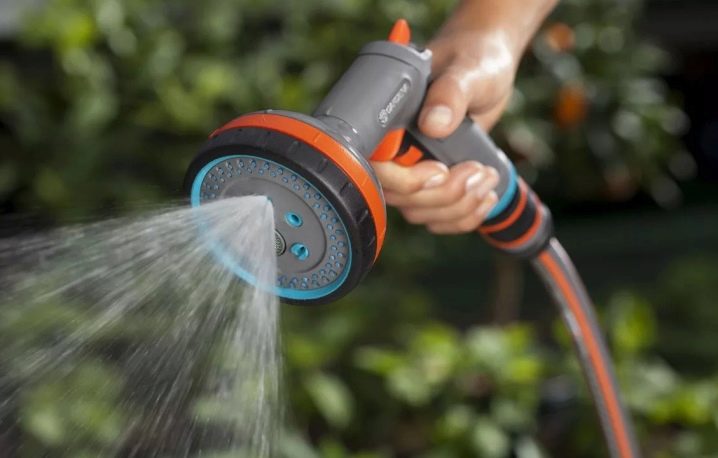
Top dressing
The best option is to apply fertilizers 1-2 times a season. At the same time, preparations are used that are focused on caring for heather. An example is Vila Yara. In parallel, pouring organic matter under each bush is allowed. In this case, peat and humus will stimulate the growth of myrikaria and have a positive effect on the color of the foliage, which will become more saturated.
Many seasoned gardeners have also successfully used mullein solution. This approach guarantees the splendor of the green mass of plantings. To prepare the solution, it will be necessary to mix the specified ingredient with water in a ratio of 1: 10. It is important to observe the proportions here, since otherwise the risk of burns to the plant increases. In addition to all the above methods of feeding, the introduction of mineral complexes is allowed in the spring.
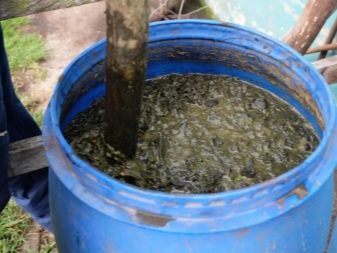
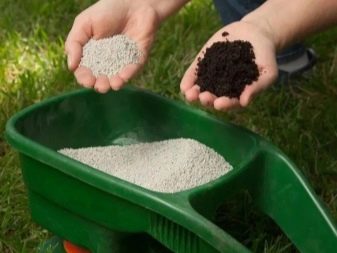
Pruning
One of the important features of the "fox tail" is that over time, the shoots of the plant will begin to lignify. In such situations, the attractiveness of the landings is predictably noticeably reduced. These problems will be most relevant if myrikaria is used as an element of landscape design. Regular pruning and clipping of the branches can help prevent trouble.
Such events are carried out in two approaches:
- in the fall (in order to form bushes and give them the necessary appearance);
- in the spring (to get rid of dry and damaged shoots during the winter period).
But it is worth noting that pruning, if necessary, can be done during the entire growing season. It is important that these activities are completed before the onset of cold weather. As the long-term practice of experienced gardeners shows, myrikaria tolerates a haircut well at any age. In this case, the best option is to give the shrub a spherical shape.
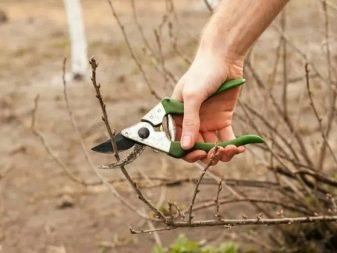
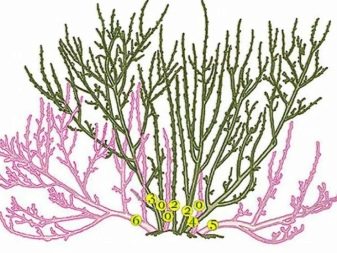
Preparing for winter
It is strongly recommended to tie the branches of the "fox's tail" before the beginning of the winter period. Otherwise, they can be damaged by snow cover or strong gusts of wind. In situations with young plants, the shoots of which are not yet lignified, you can press them to the ground and cover them with spruce branches. Non-woven fabric is an alternative.

Reproduction
At the moment, gardeners have successfully used both seed and vegetative methods of propagation of myrikaria in practice. The second method involves the separation of overgrown bushes, rooting of cuttings, or the use of root shoots as planting material. If we are talking about growing young stock from seeds, then it is important to note that seedling technology is used.
It should be borne in mind that the seed material loses its properties rather quickly after harvesting. To maintain germination, it must be properly stored. Seeds should be placed in an airtight container or other suitable packaging. The collected material must be kept at a temperature between 18-20 degrees.
Sowing is carried out only next year in the spring. In this case, stratification should be a mandatory measure. Within its framework, it is recommended to keep the future planting material in the lower part of the refrigerator for a week at temperatures ranging from +3 to +5 degrees. This approach can significantly improve seed germination, which after such a procedure reaches a record 95%. Ignoring stratification leads to the fact that about a third of the harvested seed will sprout.
Seedling boxes are successfully used as containers for sowing, which are pre-filled with appropriate nutritious and loose soil. In this situation, you can use a purchased ready-made substrate or prepare the desired mixture yourself. The second option provides for the presence in the composition of equal proportions of peat and clean river sand.
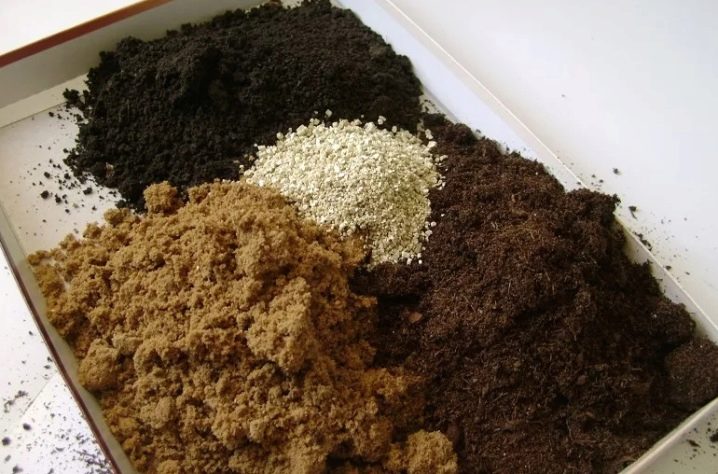
The seeds are evenly distributed over the entire surface of the soil in the box. Their small size eliminates the need for dusting and burying. For such plantings, so-called bottom watering is recommended, which in itself prevents seeds from washing out. It is noteworthy that the first shoots can be seen in 2-3 days after sowing. It is worth noting that at this stage the origin of the root process takes place. And it will take about a week to form a full-fledged shoot on the surface.
It is important to remember the need for proper care of seedlings from seeds. The list of compulsory agrotechnical measures here includes timely irrigation of the soil and ensuring the optimal temperature regime. The transfer of seedlings to open ground is carried out after it is fully strengthened. Another important condition will be persistently warm weather with average thermometer readings in the range of 10-15 degrees.
It should be remembered that even a short-term and insignificant cold snap can almost instantly destroy the young growth of the "fox's tail".

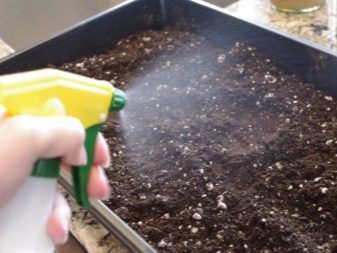
You can propagate myrikaria using other methods.
- Cuttings. In this case, it is allowed to choose both last year's and young (annual) shoots as blanks. Cuttings can be cut throughout the growing season.The length of these segments should be from 25 cm, and the thickness in situations with lignified cuttings - about 1 cm. Future seedlings are placed for several hours in stimulating solutions (Kornevin, Epin, heteroauxinic acid), after which they are immediately planted in a preliminary prepared containers filled with peat-sandy substrate.
- Root shoots. In the overwhelming majority of cases, a large number of seedlings appear around the stump of the "fox's tail". In spring, many people successfully use this growth for propagation of myrikaria bushes.
- Division of the bush. With active growth, the bush can be removed from the soil at the end of spring and carefully divided into several parts. At the same time, it is important that each resulting segment has a sufficient number of shoots and good roots. The plots must be immediately transferred to the ground to places prepared in advance, which will prevent the root system from drying out. Experts and experienced gardeners strongly recommend treating (sprinkling) with chopped charcoal before planting.
It should be borne in mind that seedlings become suitable for planting in open ground only after a year, despite the fact that their roots develop quickly. Young animals cannot safely endure the winter period. As soon as the ground warms up enough in spring, the strengthened planting material can be safely transferred to its permanent place.

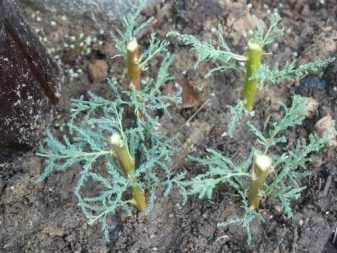
Use in landscape design
As already noted, myricaria is quite easy to grow, and caring for this crop does not require excessive efforts and significant time costs. At the same time, a unique shrub can become a real decoration of any size, configuration and purpose of the site. It is important to note that even in the absence of buds, the branches of the plants look more than impressive. It is also worth considering the aesthetics of both lonely growing bushes and whole compositions created by cutting the bush.
Tall shoots of myrikaria are widely used to form original hedges. It should be recalled that in the natural environment, the described plants prefer coastal zones. Given this feature, a good solution would be to form a bush next to natural and artificial reservoirs. As practice shows, myrikaria looks beautiful on the site next to conifers and roses. In addition, it is worth considering the option of planting next to euonymus, tenacious, sedum and periwinkle.
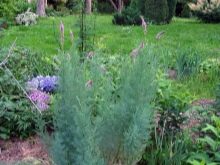
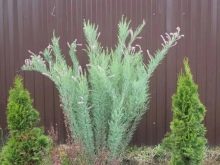
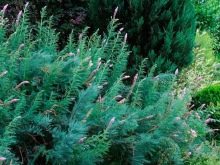













The comment was sent successfully.